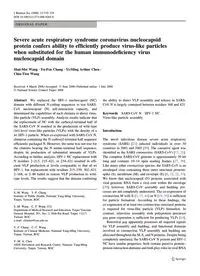
2008 Severe acute respiratory syndrome coronavirus nucleocapsid protein confers ability to efficiently produce virus-lik PDF
Preview 2008 Severe acute respiratory syndrome coronavirus nucleocapsid protein confers ability to efficiently produce virus-lik
ORIGINAL PAPER Severe acute respiratory syndrome coronavirus nucleocapsid protein confers ability to efficiently produce virus-like particles when substituted for the human immunodeficiency virus nucleocapsid domain Shui-Mei Wang Æ Yu-Fen Chang Æ Yi-Ming Arthur Chen Æ Chin-Tien Wang Received: 4 March 2008 / Accepted: 17 June 2008 / Published online: 1 July 2008 � National Science Council Taipei 2008 Abstract We replaced the HIV-1 nucleocapsid (NC) domain with different N-coding sequences to test SARS- CoV nucleocapsid (N) self-interaction capacity, and determined the capabilities of each chimera to direct virus- like particle (VLP) assembly. Analysis results indicate that the replacement of NC with the carboxyl-terminal half of the SARS-CoV N resulted in the production of wild type (wt)-level virus-like particles (VLPs) with the density of a wt HIV-1 particle. When co-expressed with SARS-CoV N, chimeras containing the N carboxyl-terminal half sequence efficiently packaged N. However, the same was not true for the chimera bearing the N amino-terminal half sequence, despite its production of substantial amounts of VLPs. According to further analysis, HIV-1 NC replacement with N residues 2–213, 215–421, or 234–421 resulted in effi- cient VLP production at levels comparable to that of wt HIV-1, but replacement with residues 215–359, 302–421, 2–168, or 2–86 failed to restore VLP production to wild- type levels. The results suggest that the domain conferring the ability to direct VLP assembly and release in SARS- CoV N is largely contained between residues 168 and 421. Keywords SARS-CoV N � HIV-1 NC � Virus-like particle assembly Introduction The novel infectious disease severe acute respiratory syndrome (SARS) [21] infected individuals in over 30 countries in 2002 and 2003 [50]. The causative agent was identified as the SARS coronavirus (SARS-CoV) [13, 21]. The complete SARS-CoV genome is approximately 30 kb long and contains 10–14 open reading frames [27, 36]. Like many other coronavirus species, the SARS-CoV is an enveloped virus containing three outer structural proteins: spike (S), membrane (M), and envelope (E) [6, 12, 22, 37]. We know that nucleocapsid (N) proteins associated with viral genomic RNA form a viral core within the envelope [29]; however, SARS-CoV assembly and budding pro- cesses are not completely understood. The co-expression of coronavirus M with E [2, 17, 44] or N [19, 35] is sufficient for particle formation. According to these findings, the co-expression of at least two coronavirus structural proteins is required for virus-like particle (VLP) formation. In contrast, retrovirus assembly with polyprotein precursor gag gene expression is sufficient for producing VLPs [14]. Retroviral gag apparently possesses all required signals for VLP assembly and budding, and functional domains involved in coronavirus VLP assembly and budding are allocated throughout the M, E, and N proteins. Despite being completely unrelated, the SARS-CoV N protein and HIV-1 NC have similar properties: both contain putative protein– protein interaction domains and both play roles in viral RNA S.-M. Wang � Y.-F. Chang Institute of Public Health, National Yang-Ming University, Taipei, Taiwan, ROC S.-M. Wang � C.-T. Wang (&) Department of Medical Research and Education, Taipei Veterans General Hospital, 201, Sec. 2, Shih-Pai Road, Taipei 11217, Taiwan, ROC e-mail:
